Feeling a bit of spring fever? Me too! I can’t wait to spend more time outside, and I'm sure your students feel the same way.
When I taught elementary math, spring was my favorite time of year. That’s because testing was over and I finally had time to do more fun, project-based math learning. Plus with better weather, I could take my students outside and teach math there!
Now that I’m at Scholastic DynaMath, I work with teachers to develop elementary math lessons that are engaging, interesting, and fun. These are my 3 favorite activities and spring-themed articles that bring real-world elementary math outside.



